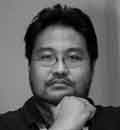EVEN if one is not really an FPJ fan, by merely being a Filipino in my generation, Fernando Poe Jr. (Ronald Allan Kelley Poe) looms large in our lives. We were the generation of television viewers. I even remember my first FPJ film on TV, "Santo Domingo," and eventually vowed to visit the location where it was shot (San Agustin Church in Intramuros). We grew up with "Kahit Konting Pagtingin," his film with the megastar Sharon Cuneta. We know his signature moves like the multiple punching and then the cymbals for the head.
My dad regaled me with stories of how, in Mindanao, FPJ could not be made to die in films because if he did, as in the biographical film "Asedillo," some of the men in the audience would shoot at the screen to defend him. The veracity of the story is hard to prove, but it reflects how beloved he was. As Zeus A. Salazar, Prospero Reyes Covar and Agustin Sotto demonstrated in their monograph "Unang pagtingin sa pelikulang bakbakan," FPJ and the action film genre where he was "Da King" are important to Filipino culture because they are a reflection of our template of the hero or "bayani" since the time of the early "bayan."
Continue reading with one of these options:
Ad-free access
P 80 per month
(billed annually at P 960)
- Unlimited ad-free access to website articles
- Limited offer: Subscribe today and get digital edition access for free (accessible with up to 3 devices)


